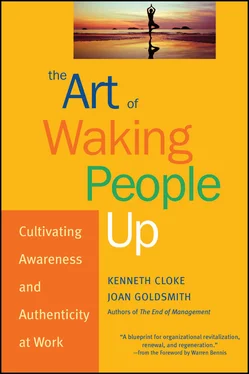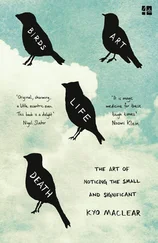But it is not necessary to experience death, loss, or pain in order to wake up. We can also do so through an experience of joy or pleasure. For example:
• A moment of intense joy. When we fall in love or experience some exquisite pleasure, we are reminded that our experience of life is shaped by our attitude toward it, which can be full of pain or pleasure, fear or adventure, sadness or joy.
• A perception of beauty. When we experience nature or are touched by a poem or work of art, we may catch a glimpse of the exquisite underlying beauty that surrounds us.
• A deep meditation. When we meditate, we may become intensely aware of the impermanence of life and the inevitability of change and wake up to living in the present.
• A recognition of absurdity. When we recognize that what is important at work, on a cosmic level, seems futile and absurd, we may surrender to a larger truth and recognize that life and work do not have to have a purpose or make sense, but can be enjoyed and experienced more deeply when we don’t take them so seriously.
• A spectacular success. When we succeed or achieve an important goal or experience successive accomplishments, we may discover that it was not the destination but the journey that truly mattered.
• A gift of honest feedback. When someone gives us the gift of deeply honest feedback, we may discover that we have the ability to change the way we act and think and begin to live our lives more authentically, skillfully, and openly.
While these pleasures encourage awareness, every waking up is also accompanied by pain caused partly by the death of a false idea of who we are. Yet this very death gives rise to a new form of pleasure in the birth of a truer, more accurate and authentic way of life. Often the thing we hold onto with all our might out of fear of loss ends up being the very thing we most need to let go of if we want to live more fully and without fear. Awareness and letting go are thus entwined and inseparable.
Seven Openings for Waking Up at Work
We all need feedback, coaching, mentoring, and assessment at various points during our work lives. These processes are necessary because our eyes focus outward rather than inward, because our language creates abstractions that separate us from direct experience, because our actions rarely bring us what we really want, because we try to hold on to pleasure and avoid pain, because we lie to ourselves about who we are to overcome feelings of inadequacy, because what we think we already know prevents us from learning anything new or different.
Yet our work lives also include moments when we are more inclined to wake up and change the way we think and act. In these moments, we become more aware of our surroundings and are able to notice that our behaviors are not as effective as we would like them to be, that we are not getting where we want to go, that we can learn something new or improve our skills, that we can choose to turn our lives around. Seven of these moments occur in every work life:
• Entry. The first opening takes place when we are hired into a new job and our attitude is optimistic and receptive to learning. We are fresh, vulnerable, and unburdened with the preconceived notions that nearly always block listening. We are responsive to feedback and willing to learn new behaviors. As beginners, we do not think we know all the answers, and are willing to entertain novel ideas and correct our mistakes simply to be accepted and succeed in a new environment.
• Aspiration. A second opportunity takes place when we consciously choose to learn and develop ourselves, or are promoted, or are given a challenging assignment, or simply desire to hone our talents and abilities. This can happen at any time in connection with any task. In doing so, we transcend lethargy, apathy, cynicism, and organizational cultures that reward minimal performance rather than maximal effort, and begin to see ourselves in a new light.
• Feedback. A third opportunity presents itself when we are given honest coaching, mentoring, or feedback by colleagues, or when we receive a performance evaluation or assessment that criticizes our work. It then becomes possible for us to identify what we can do better, clarify our goals, and develop the strategies and skills we need to succeed.
• Change. A fourth turning point appears when the rules of the game are changed and a new configuration of expectations, guidelines, and strategies is presented, for example, when a merger or consolidation takes place, or there is new leadership. Every change offers a chance to learn something new, if we can learn to recognize and exploit these opportunities.
• Leadership. A fifth opening arises when we watch leaders who model openness to learning, or when we become leaders ourselves. This opening occurs when we decide to take responsibility for our actions and inactions and the results we create, even by our subtlest intentions. Leadership is a relationship, both with others and with ourselves. Successful leadership starts by listening responsibly to what others want and learning from our mistakes.
• Failure. A sixth opportunity appears when we have failed, or are having problems or conflicts, or perceive that we are in trouble. Our difficulties can make us more rigid and entrenched, or they can teach us to set aside our defensiveness and search for fresh answers. When we adopt a learning approach, we can turn potential disasters into opportunities, achieve goals that seemed impossible and uncover countless ways of being more effective.
• Success. A seventh occasion arises when we think we are done, or have it made, or retire, or quit, or reach a peak of self-satisfaction, fulfillment, and achievement. We then have an opportunity to start all over again and reach new levels of experience and expertise. It is possible for us in these moments to explore parts of ourselves that we have suppressed or ignored, and return to being beginners.
What can organizations do to support employees during these moments and encourage lifelong learning? When we arrive as new employees, they can clarify what is expected and orient us to a culture of learning. When promotions occur, they can provide training and learning programs so that employees in transition receive the tools needed for success. When we are given feedback or assessment, they can foster a learning orientation that makes it easier for us to choose growth over defensiveness. When change occurs, they can clarify the rules, promulgate them by consensus, and make us responsible for enforcement. When leadership is exercised, they can teach us to become leaders in our own lives. When mistakes are made, they can offer tangible support to those who are not meeting expectations, speak painful truths, and encourage us to learn, repair the damage, and adopt new strategies. When we retire or are successful, they can offer continuous learning opportunities, such as leadership development, cross-training, apprenticeship programs, horizontal career ladders, and incentives that invite us to accept new responsibilities and make fresh contributions.
The choices we make at each of these decision points can also be supported by subtle signals that are sent by leaders, managers, and supervisors and messages that are communicated through organizational culture. When organizations are well led and have cultures, structures, systems, and processes that encourage individual, team, and organizational learning, improvements that may have seemed impossible now appear almost inevitable and learning becomes limitless.
At each of these openings, we confront choices that either shrink or expand our lives. We can choose to ignore what we have been told, blame the messenger or the process, resist the information, and remain stuck in patterns that restrict our potential. Or we can choose to listen, become receptive, explore the information we are receiving, examine our intentions, methods, and results, and commit to our own renewal and regeneration. Only the second choice leads to awareness, authenticity, congruence, and commitment, each of which leads, in turn, to waking up and lifelong learning.
Читать дальше











